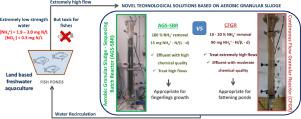Water Research ( IF 11.4 ) Pub Date : 2021-05-26 , DOI: 10.1016/j.watres.2021.117293 Sergio Santorio 1 , Ana T Couto 2 , Catarina L Amorim 2 , Angeles Val Del Rio 1 , Luz Arregui 3 , Anuska Mosquera-Corral 1 , Paula M L Castro 2

|
Ammonium and nitrite levels in water are crucial for fish health preservation and growth maintenance in freshwater aquaculture farms, limiting water recirculation. The aim of the present work was the evaluation and comparison of two granular sludge reactors which were operated to treat freshwater aquaculture streams at laboratory-scale: an Aerobic Granular Sludge - Sequencing Batch Reactor (AGS-SBR) and a Continuous Flow Granular Reactor (CFGR). Both units were fed with a synthetic medium mimicking an aquaculture recycling water (1.9–2.9 mg N/L), with low carbon content, and operational temperature varied between 17 and 25 °C. The AGS-SBR, inoculated with mature granules from a full-scale wastewater treatment plant, achieved high carbon and ammonium removal during the 157 operational days. Even at low hydraulic retention time (HRT), varying from 474 to 237 min, ammonium removal efficiencies of approximately 87–100% were observed, with an ammonium removal rate of approximately 14.5 mg NH4+-N/(L⋅d). Partial biomass washout occurred due to the extremely low carbon and nitrogen concentrations in the feeding, which could only support the growth of a small portion of bacteria, but no major changes on the reactor removal performance were observed. The CFGR was inoculated with activated sludge and operated for 98 days. Biomass granulation occurred in 7 days, improving the settling properties due to a high up-flow velocity of 11 m/h and an applied HRT of 5 min. The reactor presented mature granules after 32 days, achieving an average diameter of 1.9 mm at day 63. The CFGR ammonium removal efficiencies were of approximately 10–20%, with ammonium removal rates of 90.0 mg NH4+-N/(L⋅d). The main biological processes taking place in the AGS-SBR were nitrification and heterotrophic growth, while in the CFGR the ammonium removal occurred only by heterotrophic assimilation, with the reactor also presenting complete and partial denitrification, which caused nitrite production. Comparing both systems, the CFGR achieved 6 times higher ammonium removal rates than the AGS-SBR, being suitable for treating extremely high flows. On the other hand, the AGS-SBR removed almost 100% of ammonium content in the wastewater, discharging a better quality effluent, less toxic for the fish but treated lower flows.
中文翻译:

用于处理淡水养殖废水的顺序与连续颗粒污泥反应器
水中的铵和亚硝酸盐水平对于淡水水产养殖场的鱼类健康保护和生长维持至关重要,从而限制了水的再循环。本工作的目的是评估和比较用于处理实验室规模的淡水水产养殖流的两种颗粒污泥反应器:好氧颗粒污泥 - 序批式反应器 (AGS-SBR) 和连续流颗粒反应器 (CFGR) )。两个单元都使用模拟水产养殖循环水 (1.9–2.9 mg N/L) 的合成培养基,碳含量低,操作温度在 17 到 25 °C 之间变化。AGS-SBR 接种了来自全规模污水处理厂的成熟颗粒,在 157 天的运行期间实现了高碳和铵去除。即使在低水力停留时间 (HRT) 下,4 + -N/(L⋅d)。由于进料中的碳和氮浓度极低,导致部分生物质被冲走,只能支持一小部分细菌的生长,但没有观察到反应器去除性能的重大变化。CFGR 接种活性污泥并运行 98 天。生物质颗粒在 7 天内发生,由于 11 m/h 的高上升流速和 5 分钟的应用 HRT,改善了沉降性能。反应器在 32 天后呈现成熟颗粒,在第 63 天达到 1.9 毫米的平均直径。 CFGR 铵去除效率约为 10-20%,铵去除率为 90.0 毫克 NH 4 +-N/(L⋅d)。AGS-SBR 中发生的主要生物过程是硝化和异养生长,而在 CFGR 中,氨去除仅通过异养同化发生,反应器也呈现完全和部分反硝化作用,导致亚硝酸盐的产生。比较两种系统,CFGR 的铵去除率比 AGS-SBR 高 6 倍,适用于处理极高流量。另一方面,AGS-SBR 去除了废水中几乎 100% 的铵含量,排放出质量更好的废水,对鱼类的毒性较低,但处理的流量较低。









































 京公网安备 11010802027423号
京公网安备 11010802027423号